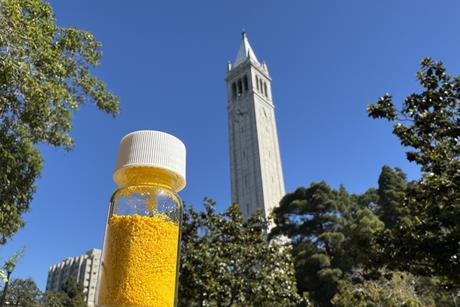Parrots’ vibrant plumage controlled by single enzyme
Mutation in gene reveals control of red and yellow pigments specific to parrots
New database highlights gaps in plastic monitoring efforts
Skeletal editing technique removes nitrogen atoms from rotaxanes
US government moves to block J&J talc bankruptcy resolution
Easy to remove tag could make mRNA synthesis for vaccines quicker and cheaper
UK’s autumn budget receives mixed response from science and education sectors
In depth
Carbon capture making slow progress in UK and Europe
Government funding welcomed, but issues over strategy and CO2 purity persist
The grim reality facing chemists in Gaza and Israel a year into war
Escalating Israel–Hezbollah conflict and Gaza war increases the pressure and threat to researchers in the region
Explainer: what is ricin?
A doctor in the UK is on trial for attempted murder with this extremely deadly poison
Explainer: Why athletes are taking sodium bicarbonate supplements
Why runners are taking pills containing a common kitchen ingredient
Explainer: Why drug shortages happen and how can we reduce them?
Record-high numbers of drugs are in short supply, from chemotherapy and antibiotics to hormone replacements
Explainer: How is the US pharmaceutical patent system being misused?
What are ‘evergreening’ and ‘thicketing’ and what is being done to reform the system and aid competition?
Twenty ways AI is advancing chemistry
List reveals how machine learning is already changing the central science
Explainer: Why have protein design and structure prediction won the 2024 Nobel prize in chemistry?
Research that has taken us from sequence to structure and back again
Protein design and structure prediction wins chemistry Nobel prize
David Baker, Demis Hassabis and John Jumper were rewarded for creating computational tools to design proteins and predict their structures that have ‘revolutionised biological chemistry’
Proteins with multiple structures open up AlphaFold’s black box
AI prediction model often fails to identify fold-switching, helping show how it works and the limits of its usefulness
Predictions for the 2024 chemistry prize highlight growing importance of AI and computational methods
Protein structure prediction, efficient simulations and clean energy among the fields tipped for recognition by chemistry’s top prize
Commission launches call for AI ‘factories’ to aid research and industry
It is hoped these facilities will help speed up development of applications in healthcare, energy, transport, defence and manufacturing
Should scientists be paid when AI chatbots use their work?
Two major scientific publishers have recently sold access to research papers to train AIs at big tech firms
Labs across the globe networked by AI discover state-of-the-art emitters for lasers
Demonstration shows how algorithms could organise timing and match specialist equipment to experiments
Worldwide
Are Indian higher education institutes gaming the ranking system?
Concerns continue to be raised about students being misled by the Indian government’s flagship scheme
Scientific freedom lacking in Africa, Unesco finds
Africa represents 12.5% of world’s population but less than 1% of its research output
New Zealand set to be first country to ban PFAS in cosmetic products
Environment agency says it is taking a ’precautionary approach’ to PFAS in nail polish, shaving cream, foundation, lipstick and mascara
UK’s autumn budget receives mixed response from science and education sectors
R&D spending is protected, but university budgets will be impacted by national insurance hikes
Are Indian higher education institutes gaming the ranking system?
The grim reality facing chemists in Gaza and Israel a year into war
Science community holds its breath again as consequential US presidential election looms
Chemistry courses, departments face closure in the UK highlighting higher education’s financial woes
UK’s autumn budget receives mixed response from science and education sectors
R&D spending is protected, but university budgets will be impacted by national insurance hikes
Thousands of published studies may contain images with incorrect copyright licences
Questions raised over copyright licence that covers images created using scientific illustration service Biorender
Chemist found to have falsified data in 42 papers has notched up 13 retractions so far
Open letter from fraud sleuths raises concerns over research integrity at Scientific Reports
‘Stealth corrections’ uncovered in scientific journals, raising transparency concerns
Widespread signs of paper milling discovered in materials science and engineering papers
UK’s autumn budget receives mixed response from science and education sectors
R&D spending is protected, but university budgets will be impacted by national insurance hikes
Nobel prize-winning scientists mobilise for Kamala Harris
82 Nobel laureates warn of the threat Donald Trump poses to science, climate and living standards
Carbon capture making slow progress in UK and Europe
Government funding welcomed, but issues over strategy and CO2 purity persist
Argentina’s researchers face continued catastrophe under Javier Milei
Drug companies reluctantly accept state price negotiations
RSC calls on government to address lab space shortage
EU’s new research commissioner named
UK’s Grangemouth refinery will close in 2025
Commission launches call for AI ‘factories’ to aid research and industry
US–China science and technology accord expires, maybe for the last time
Carbon capture COF shows impressive ability to survive hundreds of cycles
Fast take-up and low regeneration temperatures make direct air capture promising
Isotope tracking suggests that plants cycle carbon faster than previously thought
New analysis suggests that vegetation is less able to offset climate change than had previously been calculated
Hydroxide-loaded sponge soaks up atmospheric carbon dioxide
Low-cost charcoal absorbs carbon dioxide and rapidly releases it in energy-efficient process
Recycled construction waste could cut cement and steel’s carbon footprint
Cement can be regenerated during steel recycling in an electric arc furnace
Nobel prize winners far more likely to come from wealthy families highlighting inequality in the sciences
Winners today come, on average, from less wealthy families than when the prize began but there is still a long way to go
Women stay in science far longer than thought, study of OECD countries suggests
Analysis of publications reveals that, on average, women ‘survive’ as long as men across 16 scientific disciplines
Indian scheme to provide 300 research grants for women
The announcement made by India’s science and technology minister aims to foster more cross-disciplinary research
Next president of the Royal Society of Chemistry will be Robert Mokaya
University of Nottingham chemist will begin his tenure in 2026
Gender equality report highlights progress and challenges for women in research
Humphry Davy’s whole story – warts and all – deserves to be told
Universities in the UK beat national average on gender pay gap but large discrepancies remain
UKRI investigation clears diversity panel following science minister’s accusations of extremism
US researcher vows to appeal after losing her disability discrimination suit

































